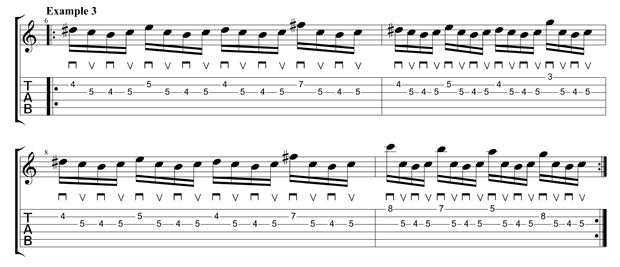Five Ways to Put the Pedal to the Neo-Classical Metal

These days, “Neo-classical” gets a bad rap from many players, but in its prime, the neo-classical movement inspired an era of innovation and accelerated evolution in the world of guitar.
Spearheaded by Yngwie Malmsteen and Randy Rhoads, inspired by Uli Jon Roth and Ritchie Blackmore (and Bach, Mozart, Paganini, etc.) and taken to its heights by Jason Becker, Marty Friedman, Tony MacAlpine and the other early Shrapnel Records artists, the neo-classical period in modern rock guitar was a time of previously unimaginable technical progress and harmonic inventiveness.
Why? Because it was fun to play and sounded cool!
One of the coolest components of the neo-classical sound, which will work in all musical styles, is the use of pedal points (AKA pedal tones: repeating, static notes. Think the first half of the “Crazy Train” riff or the Halloween theme). And since no discussion of neo-classical musical theory would be complete without some Italian terminology, the following examples in E harmonic minor (E, F#, G, A, B, C, D#) use pedal points in ostinato-type phrasing, with a repeating musical pattern.
Getting fluent with this type of phrasing can add a thematic element to your playing and help you create attention-grabbing passages that will bring your improvisations to new musical heights. EXAMPLE 1 uses the E note at the 12th fret on the high E string as its pedal tone, and the ostinato is the “12-11-12." The first note of each 16th note group changes with every beat. Use your index finger for all of the changing notes except use your middle finger for the A (10th fret) on the B string.

EXAMPLE 2 contains a larger ostinato in the groupings of the high E string notes with a pinky note pedal point, and the changing notes ascend the B string chromatically. Slash uses an idea similar to this on his new track, “Anastasia” (email anastasia@guitarstrength.com for a transcription of the version found in the song).

Moving the pedal tone and repeating phrase to the lower register of the overall melodic pattern, the George Lynch-inspired EXAMPLE 3 creates a forceful rhythmic push. Note the downstrokes on the changing notes throughout and the shift in the pattern in the fourth bar.

Inspired by Paganini, Yngwie and Joe Stump, EXAMPLE 4 moves the ostinato into another direction, ultimately moving across four strings and including an “inside” picked string skip.

Finally, EXAMPLE 5 moves the pedal and ostinato into an even lower range, creating a killer rhythm riff that players like Jeff Loomis love. Try it fast using strict alternate picking or lay into it with straight downpicking at a driving pace.

While the neo-classical trend may have died as a result of a glut of imitators who ceased to innovate, its spirit lived as a component in the playing of guitar masters such as Steve Vai, Joe Satriani, Paul Gilbert, George Lynch and John Petrucci. Modern shredders such as Chris Broderick, Jeff Loomis and Alexi Laiho continue to use the template set by the neoclassical masters to inform their creation of the next level of guitar music, while countless new rock and metal bands discover and are newly inspired by the movement every day. Just like the classical music that inspired it, the popular use of the neo-classical genre is a sleeping giant ready to awaken.
Check out some Perpetual Burn-era Jason Becker and some of the other amazing guitar work from the time to get inspired and look for some other tricks to take your own playing to the next level. Happy shredding!
Scott Marano has dedicated his life to the study of the guitar, honing his chops at the Berklee College of Music under the tutelage of Jon Finn and Joe Stump and working as an accomplished guitarist, performer, songwriter and in-demand instructor. In 2007, Scott developed the Guitar Strength program to inspire and provide accelerated education to guitarists of all ages and in all styles through state-of-the-art private guitar lessons in his home state of Rhode Island and globally via Skype. Visit Scott and learn more at www.GuitarStrength.com.
Get The Pick Newsletter
All the latest guitar news, interviews, lessons, reviews, deals and more, direct to your inbox!
Scott Marano has dedicated his life to the study of the guitar, honing his chops at the Berklee College of Music under the tutelage of Jon Finn and Joe Stump and working as an accomplished guitarist, performer, songwriter and in-demand instructor. In 2007, Scott developed the Guitar Strength program to inspire and provide accelerated education to guitarists of all ages and in all styles through state-of-the-art private guitar lessons in his home state of Rhode Island and globally via Skype.
“There are so many sounds to be discovered when you get away from using a pick”: Jared James Nichols shows you how to add “snap, crackle and pop” to your playing with banjo rolls and string snaps
Don't let chord inversions bamboozle you. It's simply the case of shuffling the notes around







![Joe Bonamassa [left] wears a deep blue suit and polka-dotted shirt and plays his green refin Strat; the late Irish blues legend Rory Gallagher [right] screams and inflicts some punishment on his heavily worn number one Stratocaster.](https://cdn.mos.cms.futurecdn.net/cw28h7UBcTVfTLs7p7eiLe.jpg)


